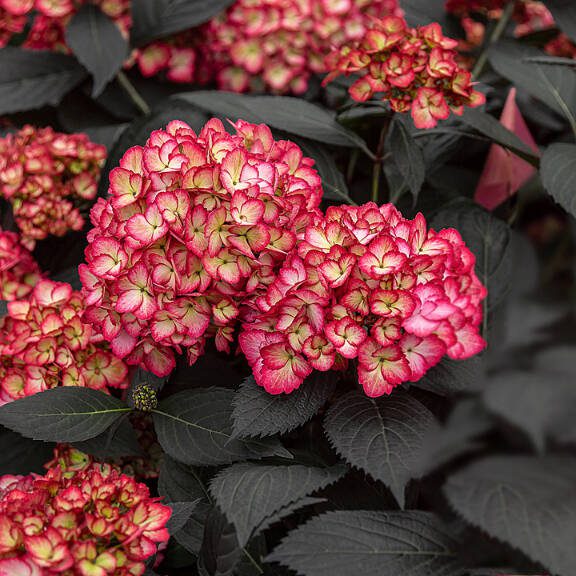By Trevor Cameron / The Golfing Gardener
Gardeners are always on the lookout for shrubs that have an extended bloom time, particularly over the months of summer.
Some of the best choices in our area are hydrangeas, as these beauties start blooming in June or July and most will give continuous flower power all the way through fall until frost. There are excellent varieties for full sun, and many others for partial shade.
Mopheads vs. lacecaps: Typically, gardeners think of a hydrangea with mophead flower — the classic rounded, blue flower we see everywhere in the summer. Lacecap flowers are flatter and have sterile centers, offering an airy and more graceful alternative. Almost all, with just a few exceptions, of these bigleaf types (hydrangea macrophylla cvs.) prefer a morning sun/afternoon shade location in the garden. Feeding them once in March and again in June with an organic fertilizer is ideal. And then pruning them in March is best, removing any dead wood and simply cutting longer stems back a bit to control size and increase flower production.
Keep your panicles on in the sun: The panicle-type bloomers are what we call PG-type hydrangeas (hydrangea paniculata grandiflora), all of which love sun and sport huge cone-shaped flowers all summer long. These open either a limey-green or white color, then age over the summer into shades of pinks to reds. These flowers do not change color with pH (see below), and all PGs bloom on new wood, making them easy to prune back each March to control their size. Individual flowers can be densely packed with florets or more open and airy, depending on the specific cultivar. Feed them each March and June, as well, with organic fertilizer for best performance. PGs can also be found in a tree form, which is perfect as a manageable, smaller, summer-blooming landscape tree.
Old school vs. new school: There is nothing wrong with old-fashioned varieties of any plant, including hydrangeas. However, with the mophead and lacecap types mentioned above, there is one major difference with newer cultivars: They are repeat bloomers, all summer long, blooming on both new and old wood, simplifying pruning each spring. Old varieties only bloom on old wood, which means if we cut them back in spring too hard we will sacrifice flowering the following summer. With newer options, we can cut them back much harder and they will still flower, offering maximum bloom on a shorter, more compact plant.
To go acidic or alkaline, that is the question: We are blessed with mostly acidic soils in our local climate, which means our mophead and lacecap bigleaf hydrangeas will display flowers in lavender, blue and purple tones. This is tough as many of the plants for sale in garden centers will not be blooming the same color as they will be in your yard. Often soil from growers is neutral, or slightly alkaline even, which will produce pink to red blooms. You can always play with your pH levels and thus flower color (if you are up for it) by using aluminum sulfate (acid) or potassium nitrate (alkaline) as amendments. Keep in mind that neither of these are fertilizers, but rather pH adjusters; You are creating a small area around your hydrangea that will trick it into blooming the color you desire. Other things such as coffee grounds (acid) or lime (alkaline) may help, as well, but if you are going bold, be sure to use the two suggested compounds as they act quickly.
White is making a comeback: If we go back to mophead and lacecap hydrangeas for a moment, there are some sweet cultivars that stay bright white and do not take on much pink or blue color. They are not pH dependent and the white flowers pop in any partial shady area, for sure. Seek out ones like Blushing Bride and Cape Lookout. If you have a sunny location and love white, explore your options with another species: hydrangea arborescens, what we call smooth hydrangeas. These are super hardy, love sun and sport huge, rounded, pure white flowers all summer long. Look for useful cultivars like I or Wee White.
There are a couple “collections” of hydrangeas to look for, all of which I have had excellent luck with here at our nursery and in my own garden. For bigleaf hydrangeas, the Endless Summer Collection from Bailey Nurseries contains repeat blooming and fabulous, compact growers, such as Summer Crush, Bloomstruck and Pop Star. The Seaside Serenade Series from Monrovia Growers offers us a bunch of worthy garden companions, such as Newport, Crystal Cove and Glacier Bay. If you are looking for full sun and like the PG-type hydrangeas, explore the First Editions plants from Bailey Nurseries as they have some great varieties like Diamond Rouge, Strawberry Sundae, Vanilla Strawberry, Berry White and Little Hottie. One more to salivate over is the brand new Eclipse hydrangea, an unbelievable shrub with dark purple-black foliage that takes some sun and sports a red/white mophead type flower; It’s the plant of the year if you ask me.
Shrubs like hydrangeas are summer garden staples and, when cared for, should bring you a lifetime of garden enjoyment.
Free class
Sunnyside Nursery in Marysville will host “Hydrangealicious” at 10 a.m. on Saturday, July 13. For more information or to sign up, go to www.sunnysidenursery.net/classes.
Trevor Cameron is a certified professional horticulturist (CPH) and serves as general manager for Sunnyside Nursery in Marysville. He can be reached at sunnysidenursery@msn.com.
Talk to us
> Give us your news tips.
> Send us a letter to the editor.
> More Herald contact information.




























